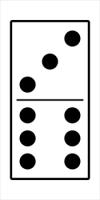What is a Fact Family?

Has your child come home with something similar to a problem stating: Write the fact family for 5, 13, 8 with no examples in sight? Well, this article is for parents who have to help their children with Fact Family homework. Let’s look at an example:
8 + 5 = 13
5 + 8 = 13
13 – 8 = 5
13 – 5 = 8
Generally, the word family means certain people are related. Likewise, fact family implies that certain numbers and facts are related.
For starters, they are only three numbers in each family. In the above fact family, the members are 5, 8, and 13.
How are they related?
*** You can add two of the numbers together to get the third number.
8 + 5 = 13
*** You can switch the order of the two numbers added above to equal the third number again. In math, this is referred to as the commutative property of addition.
5 + 8 = 13
Cousin Operators or Operands
*** Just as your sister/brother’s children are your children’s cousins, addition is related to subtraction via the term inverse property. Subtraction is the inverse property of addition. In other words, subtraction is the opposite of addition. We can undo the work of addition by subtracting. This is very important to remember for problem solving.
How to get the last two math facts of the family . . .
So far we’ve recreated 8 + 5 = 13 and 5 + 8 = 13
Since we know the inverse (opposite) of addition is subtraction, start with the sum (or the larger number), 13, and subtract one of the addends. 13 – 8 = 5 Of course, your answer is the third number. In this case, the answer is 5. Thus the next fact would be, 13 – 5 = 8.
Usefulness:
Consider this word problem:
Susan had 5 pencils. Her grandmother gave her more pencils for her collection. Susan now has 13 pencils. How many pencils did Susan’s grandmother give her?
If a student has an understanding of fact family concept, he/she could rebuild the family.
You know that Susan started out with 5 pencils and ended up with 13 pencils. Thus, you know two of the family members. They are 5 and 13. In math language that translates,
5 pencils + ____ more pencils = 13 pencils or 5 + ? = 13
Let’s look at the fact family again.
5 + ? = 13
? + 5 = 13
13 – 5 = ?
13 - ? = 5
Which equation above would give me the value of ‘?” ? Answer: The third equation. Hey, we just need to subtract 5 from 13 to learn that her grandmother gave her 8 pencils.
If your child did not know their addition and subtraction facts well, teaching them concept would definitely help.
What about Multiplication and Division?
Yes, there related. Division is the inverse property of Multiplication. Thus, the same principle applies. Study the example below.
6 x 4 = 24
4 x 6 = 24
24 / 6 = 4
24/ 4 = 6
(The “/” represents division.)
Practice:
Let’s use dominoes to practice with addition and subtraction.

Use each side of the domino as an addend to form the first addition fact. Allow the student to count all of dots to get the answer or sum.
6 + 3 = 9
Change the order of the addends:
3 + 6 = 9
Use the inverse property of addition
9 – 6 = 3
9 – 3 = 6
The Fact Family by Turley includes 32 student activity sheets and paper manipulatives.
8 + 5 = 13
5 + 8 = 13
13 – 8 = 5
13 – 5 = 8
Generally, the word family means certain people are related. Likewise, fact family implies that certain numbers and facts are related.
For starters, they are only three numbers in each family. In the above fact family, the members are 5, 8, and 13.
How are they related?
*** You can add two of the numbers together to get the third number.
8 + 5 = 13
*** You can switch the order of the two numbers added above to equal the third number again. In math, this is referred to as the commutative property of addition.
5 + 8 = 13
Cousin Operators or Operands
*** Just as your sister/brother’s children are your children’s cousins, addition is related to subtraction via the term inverse property. Subtraction is the inverse property of addition. In other words, subtraction is the opposite of addition. We can undo the work of addition by subtracting. This is very important to remember for problem solving.
How to get the last two math facts of the family . . .
So far we’ve recreated 8 + 5 = 13 and 5 + 8 = 13
Since we know the inverse (opposite) of addition is subtraction, start with the sum (or the larger number), 13, and subtract one of the addends. 13 – 8 = 5 Of course, your answer is the third number. In this case, the answer is 5. Thus the next fact would be, 13 – 5 = 8.
Usefulness:
Consider this word problem:
Susan had 5 pencils. Her grandmother gave her more pencils for her collection. Susan now has 13 pencils. How many pencils did Susan’s grandmother give her?
If a student has an understanding of fact family concept, he/she could rebuild the family.
You know that Susan started out with 5 pencils and ended up with 13 pencils. Thus, you know two of the family members. They are 5 and 13. In math language that translates,
5 pencils + ____ more pencils = 13 pencils or 5 + ? = 13
Let’s look at the fact family again.
5 + ? = 13
? + 5 = 13
13 – 5 = ?
13 - ? = 5
Which equation above would give me the value of ‘?” ? Answer: The third equation. Hey, we just need to subtract 5 from 13 to learn that her grandmother gave her 8 pencils.
If your child did not know their addition and subtraction facts well, teaching them concept would definitely help.
What about Multiplication and Division?
Yes, there related. Division is the inverse property of Multiplication. Thus, the same principle applies. Study the example below.
6 x 4 = 24
4 x 6 = 24
24 / 6 = 4
24/ 4 = 6
(The “/” represents division.)
Practice:
Let’s use dominoes to practice with addition and subtraction.

Use each side of the domino as an addend to form the first addition fact. Allow the student to count all of dots to get the answer or sum.
6 + 3 = 9
Change the order of the addends:
3 + 6 = 9
Use the inverse property of addition
9 – 6 = 3
9 – 3 = 6
The Fact Family by Turley includes 32 student activity sheets and paper manipulatives.
You Should Also Read:
Multiplication Practice Ideas
More Multiplication Practice Ideas
Multiplication Tips - 2s, 4s, 8s

Related Articles
Editor's Picks Articles
Top Ten Articles
Previous Features
Site Map
Content copyright © 2023 by Beverly Mackie. All rights reserved.
This content was written by Beverly Mackie. If you wish to use this content in any manner, you need written permission. Contact Beverly Mackie for details.




